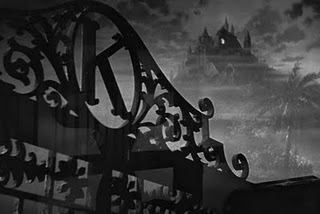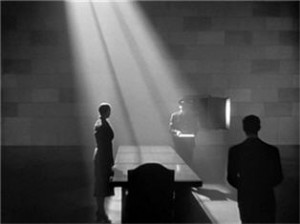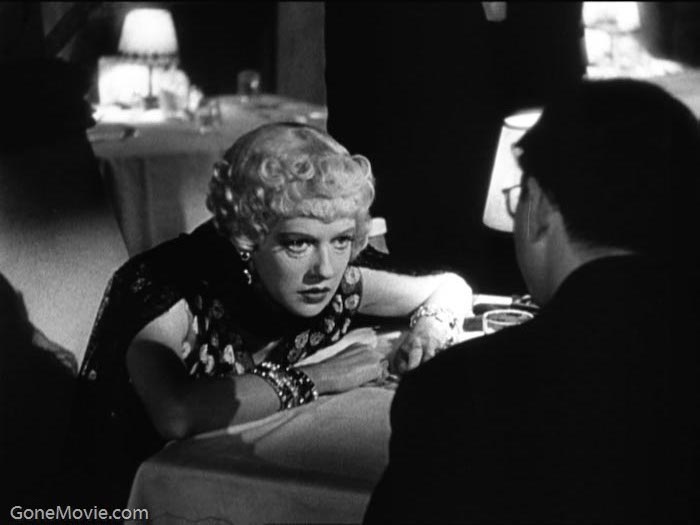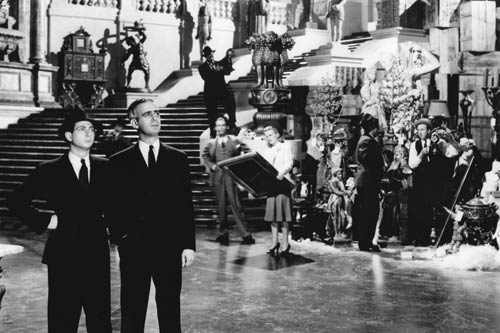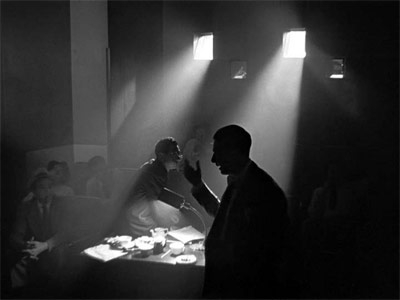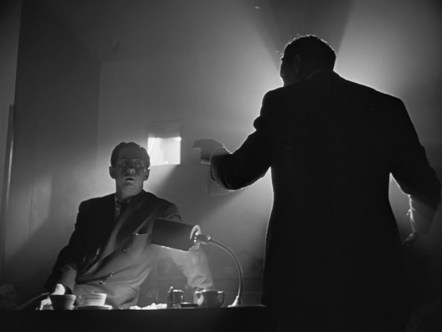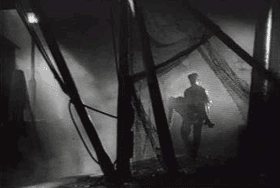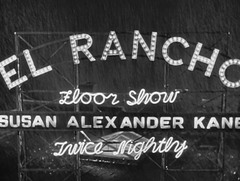From the Spring 1972 issue of Film Comment; this is also reprinted, with a lot of contextual material, in my 2007 collection Discovering Orson Welles (where I’ve also retained my original title — not used by Film Comment, who ran it as an untitled review). I’m still hugely embarrassed by the assertion early in this piece that “[Kael’s] basic contention, that the script of KANE is almost solely the work of Herman J. Mankiewicz, seems well-supported and convincing” — a howler if there ever was one. I’m not sure if this would qualify as a valid excuse, but this was the first lengthy essay about film that I ever published. My joint audio commentary with Jim Naremore on Criterion’s new KANE box set addresses some of Kael’s more dubious factual and critical assumptions.
Recently I‘ve been reading Brian Kellow’s biography of Pauline Kael, and I’m very pleased that he’s up front about the serious flaws of “Raising KANE,” factual and otherwise — but also disappointed that Kellow is unaware that “The Kane Mutiny” — signed by Peter Bogdanovich, and the best riposte to Kael’s essay ever published by anyone — was mainly written by Welles himself. (See This is Orson Welles and Discovering Orson Welles for more about this extraordinary act of impersonation.) It appears that the main source of this doubtful assumption in Kellow’s book is Bogdanovich himself. Of course, Peter knows far better than I or Kellow do who wrote what, but one fact worthy of consideration in this matter is that he’s never reprinted “The Kane Mutiny” in any of his books (apart from the portions of his interview with Welles from that piece that I chose to recycle in This is Orson Welles). I also happen to think that this essay is superior, as prose and as argument, to anything else ever published under Peter’s name.
I was delighted to discover that the following review is included in the collection of Welles’ papers purchased from Oja Kodar that are now housed at the University of Michigan in Ann Arbor. On the other hand, whether Welles read it before or after I met him is something I’ll never know. –- J.R.
The conceptions are basically kitsch…popular melodrama -– Freud plus scandal, a comic strip about Hearst.
Although these words are used by Pauline Kael to describe CITIZEN KANE, in a long essay introducing the film’s script, they might apply with greater rigor to her own introduction. Directly after the above quote, she makes it clear that KANE is “kitsch redeemed,” and this applies to her essay as well: backed by impressive research, loaded with entertaining nuggets of gossip and social history, and written with a great deal of dash and wit, “Raising KANE” is a work that has much to redeem it. As a bedside anecdote collection, it is easily the equal of The Minutes of the Last Meeting and Robert Lewis Taylor’s biography of W. C. Fields, and much of what she has to say about Hollywood is shrewd and quotable (e.g., “The movie industry is always frightened, and is always proudest of films that celebrate courage.”) Her basic contention, that the script of KANE is almost solely the work of Herman J. Mankiewicz, seems well-supported and convincing — although hardly earth-shaking for anyone who was reading Penelope Houston’s interview with John Houseman in Sight and Sound nine years ago (Autumn 1962). But as criticism, “Raising KANE” is mainly a conspicuous failure — a depressing performance for a supposedly major film critic — in which the object under examination repeatedly disappears before our eyes. Contrary to her own apparent aims and efforts, Kael succeeds more in burying KANE than in praising it, and perpetrates a number of questionable critical methods in the process. The following remarks will attempt to show how and why.
First, a word about The CITIZEN KANE Book itself, which appears to be a fair reflection of Kael’s tastes and procedures. In many ways, it epitomizes the mixed blessing that the proliferating movie book industry has generally become: one is offered too much, yet not enough, and usually too late. Thirty years after the release of CITIZEN KANE, the script is finally made available, and it is packaged to serve as a coffee table ornament — virtually out of the reach of most students until (or unless) it comes out as an expensive paperback, and illustrated with perhaps the ugliest frame enlargements ever to be seen in a film book of any kind. (1) One is grateful for much of the additional material — notes on the shooting script by Gary Carey, Mankiewicz’s credits, an index to Kael’s essay, and above all, the film’s cutting continuity — and a bit chagrined that (1) no production stills are included, (2) Carey’s notes are somewhat skimpy, and (3) apart from THE MAGNIFICENT AMBERSONS, FALSTAFF, and MR. ARKADIN, no other titles directed by Welles are even mentioned (and the latter, inexplicably, is listed only under its British title, CONFIDENTIAL REPORT).
When Kael began carving her reputation in the early Sixties, she was chiefly known for the vigorous sarcasm of her ad hominem attacks against other critics. Now that she writes for a vastly wider audience in The New Yorker (where “Raising KANE” first appeared), the sarcasm is still there, but generally the only figures attacked by name are celebrities — like Orson Welles; the critics are roasted anonymously. This may be due to professional courtesy, or the likelier assumption that New Yorker readers don’t bother with film books by other writers, but it makes for an occasional fuzziness. Thus we have to figure out on our own that “the latest incense-burning book on Josef von Sternberg” is Herman G. Weinberg’s; and that when she ridicules “conventional schoolbook explanations for [KANE’s] greatness,” such as “articles…that call it a tragedy in fugal form and articles that explain that the hero of CITIZEN KANE is time,” she is referring not to several articles but to one -– specifically, an essay by Joseph McBride in Persistence of Vision. (2) The opening sentence of McBride’s piece reads, “CITIZEN KANE is a tragedy in fugal form; thus it is also the denial of tragedy,” and three paragraphs later is the suggestion that “time itself is the hero of CITIZEN KANE.” Yet taken as a whole, McBride’s brief essay, whatever it may lack in stylistic felicities, may contain more valuable insights about the film than Kael’s 70-odd double-columned pages. While it shows more interest in KANE as a film than as the setting and occasion for clashing egos and intrigues, it still manages to cover much of the same ground that The CITIZEN KANE Book traverses three years later — detailed, intelligent comparisons of the shooting script with the film (the first time this was ever done, to my knowledge), an examination of the movie’s relationship to Hearst, and a full acknowledgement (amplified by a quotation from the Houseman interview) that “Welles does play down Mankiewicz’s contribution.” And if we turn directly to Kael’s own account of KANE published in Kiss Kiss Bang Bang the same year, we find not only “conventional school book explanations” that are vacuous indeed (Kane is “a Faust who sells out to the devil in himself”), but also the assumption that KANE is “a one man show …staged by twenty-five-year-old writer-director-star Orson Welles.”
For all its theoretical limitations and embarrassing factual errors, the best criticism of CITIZEN KANE is still probably found in André Bazin’s small, out-of-print, and untranslated book on Welles (Orson Welles, Paris: P.-A. Chavane, 1950). It is one sign of Kael’s limitations that she once wrote in a book review about Bazin’s essays being “brain-crushingly difficult” — in English translation. A brain that easily crushed is somewhat less than well equipped to deal with intellectual subjects, as her early remarks on Eisenstein and Resnais (among others) seem to indicate. IVAN THE TERRIBLE, for her, is “so lacking in human dimensions that we may stare at it in a kind of outrage. True, every frame in it looks great…but as a movie, it’s static, grandiose, and frequently ludicrous, with elaborately angled, over-composed photography, and overwrought, eyeball-rolling performers slipping in and out of the walls….Though no doubt the extraordinarily sophisticated Eisenstein intended all this to be a non-realistic stylization, it’s still a heavy dose of décor for all except true addicts” (Kiss Kiss Bang Bang). And LAST YEAR AT MARIENBAD is “a ‘classier’ version of those Forties you-can-call-it-supernatural-if-you-want-to movies like FLESH AND FANTASY — only now it’s called ‘Jungian’” (I Lost It at the Movies). Basic to both these reactions is a refusal or inability to respond to self-proclaiming art on its own terms, an impulse to cut the work down to size — or chop it up into bite-size tidbits — before even attempting to assimilate it. At her rare best, as in her sensitive review of MCCABE AND MRS. MILLER last year, Kael can grapple with a film as an organic unity; more frequently, it becomes splintered and distributed into ungainlv heaps of pros and cons, shards of loose matter that are usually dropped unless they can yield up generalities or wisecracks, until all that remains visible is the wreckage. Many films, of course, are wreckage, and few critics are better than Kael in explaining how certain ones go over the cliff — the complex (or simple) mentality that often lies just behind banality or incoherence. But confronting the depth of KANE, she can hail it only as a “shallow masterpiece.”
Small wonder, then, that so much of the film confuses or eludes her. First she tries to “explain” as much of the film as she can by relating it to the biographies, public personalities, and (presumed) psychologies of Welles, Mankiewicz and Hearst (”Freud plus scandal”). And when some parts of the film don’t seem to match her “real-life” drama, she connects them anyway: “There’s the scene of Welles eating in the newspaper office, which was obviously caught by the camera crew, and which, to be ‘a good sport,’ he had to use.” But what’s so obvious or even plausible about this fantasy when we find the eating scene already detailed in the script?
Kael is at her weakest when she confronts the film’s formal devices. The use of a partially invisible reporter as a narrative device, for instance -– training our attention on what he sees and hears rather than on what he is — clearly confuses her. After criticizing William Alland in a wholly functional performance for being “a vacuum as Thompson, the reporter,” she goes on to note that “the faceless idea doesn’t really come across. You probably don’t get the intention behind it in KANE unless you start thinking about the unusual feebleness of the scenes with the ‘News on the March’ people and the fact that though Thompson is a principal in the movie in terms of how much he appears, there isn’t a shred of characterization in his lines or performance; he is such a shadowy presence that you may even have a hard time remembering whether you ever saw his face…”
Quite aside from the speculation she sets up about “the scenes with the ‘News on the March’ people” (isn’t there only one?), it is distressing — and unfortunately, not uncharacteristic — to see her treating one of the film’s most ingenious and successful strategies as a liability. Where, indeed, can one find the “unusual feebleness” in the brilliant projection-room sequence — a model of measured exposition, a beautiful choreography of darting sounds and images, dovetailing voices and lights — except in her misreading of it? Kael’s use of the second person here, like her resort to first person plural on other occasions, is ultimately as political and rhetorical as it is anti-analytical: one is invited to a party where only one narrow set of tastes prevails.
It’s hard to make clear to people who didn’t live through the transition[from silent to sound films] how sickly and unpleasant many of those ‘artistic’ silent pictures were — how you wanted to scrape off all that mist and sentiment.
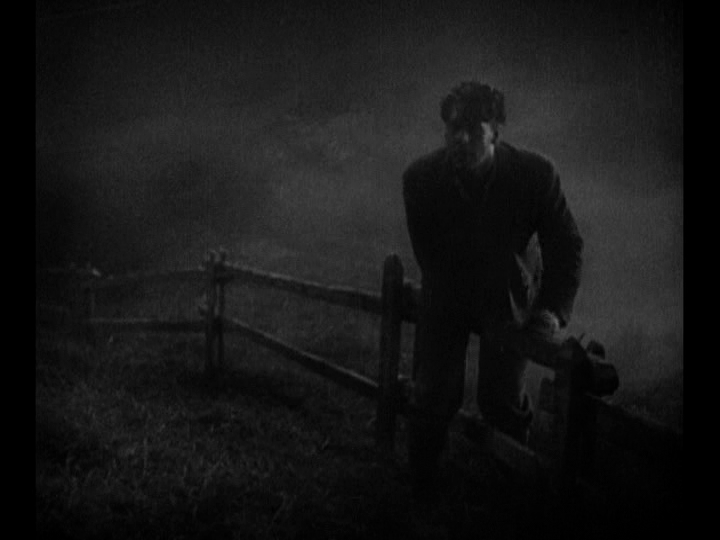
It’s hard indeed if you (Kael) fail to cite even one film as evidence — does she mean SUNRISE or THE DOCKS OF NEW YORK (lots of mist and sentiment in each), or is her knife pointed in another direction? — but not so hard if you (Kael) don’t mind bolstering the prejudices of your lay audience: they’d probably like to scrape off “all that silent ‘poetry’” too, and producers at the time with similar biases often did it for them.
Kael finds a similar difficulty in taking KANE straight:
The mystery…is largely fake, and the Gothic-thriller atmosphere and the Rosebud gimmickry (though fun) are such obvious penny-dreadful popular theatrics that they’re not so very different from the fake mysteries that Hearst’s American Weekly used to whip up — the haunted castles and the curses fulfilled.
Within such a climate of appreciation, even her highest tributes come across as backhanded compliments or exercises in condescension, as in her reversions to nostalgia. Having established why none of us should take KANE very seriously, she grows rhapsodic: “Now the movie sums up and preserves a period, and the youthful iconoclasm is preserved in all its freshness — even the freshness of its callowness.”
But if Kael can be dreamy about the past, she also records her misgivings about film as “the nocturnal voyage into the unconscious” (Buñuel’s phrase): “Most of the dream theory of film, which takes the audience for passive dreamers, doesn’t apply to the way one responded to silent comedies–which, when they were good, kept the audience in a heightened state of consciousness.” But does a dreamer invariably relate to his own dream — much less someone else’s – passively? And are “dreams” and “a heightened state of consciousness” really antithetical?
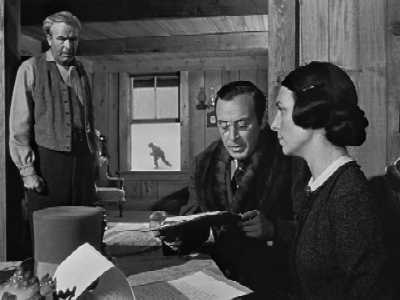
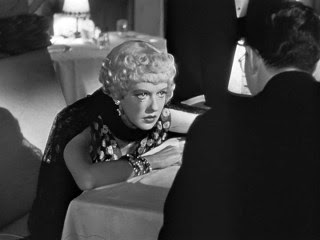
Much of the beauty of CITIZEN KANE, and Welles’ style in general, is a function of kinetic seizures, lyrical transports, and intuitive responses. To see KANE merely as the “culmination” of Thirties comedy or “a collection of blackout sketches” or a series of gibes against Hearst is to miss most of what is frightening and wonderful and awesome about it. When the camera draws back from the child surrounded by snow through a dark window frame to the mother’s face in close-up, one feels a free domain being closed in, a destiny being circumscribed, well before either the plot or one’s powers of analysis can conceptualize it. As Susan Alexander concludes her all-night monologue, and the camera soars up through the skylight over her fading words (”Come around and tell me the story of your life sometime”), the extraordinary elation of that movement is too sudden and too complex to be written off as superficial bravura: a levity that comes from staying up all night and greeting the dawn, the satisfaction of sailing over a narrative juncture, the end of a confession, a gesture of friendship, the reversal of an earlier downward movement, a sense of dramatic completion, a gay exhaustion, and more, it is as dense and immediate as a burst of great poetry. At its zenith, this marvelous art –- which is Welles’ and Welles’ alone –- can sketch the graceful curve of an entire era; in the grand ball of THE MAGNIFICENT AMBERSONS, perhaps the greatest achievement in his career, a track and dissolve through the mansion’s front door, while a fleeting wisp of garment flutters past, whirls us into a magical continuum where the past, present and future of a family and community pirouette and glide past our vision–the voices and faces and histories and personal styles flowing by so quickly that we can never hope to keep up with them.
What has Kael to say about AMBERSONS? It’s “a work of feeling and imagination and of obvious effort…but Welles isn’t in it [as an actor], and it’s too bland. It feels empty, uninhabited.” It’s nice of her, anyway, to give him an A for effort.
Throughout “Raising KANE,” a great show is made of clearing up popular misconceptions about Welles. Yet within my own experience, the most popular misconception is not that Welles wrote CITIZEN KANE (although that’s popular enough), but that he “made” or “directed” THE THIRD MAN. And the worst that can be said about Kael’s comments is that they don’t even say enough about his style as a director to distinguish it from Carol Reed’s. So intent is she on documenting Welles’ vanity that the films wind up seeming secondary, trails of refuse strewn in the wake of the Great Welles Myth, and many of his finest achievements are denied him.
Seeing KANE again recently, she reports that “most of the newspaper-office scenes looked as clumsily staged as ever” (no reasons or explanations given). With a sweep of her hand, she consigns the rich complexity of THE LADY FROM SHANGHAI and TOUCH OF EVIL to oblivion: “His later thrillers are portentous without having anything to portend, sensational in a void, entertaining thrillers, often, but mere thrillers.” (Like James Bond?) A page later, noting “the presence in KANE of so many elements and interests that are unrelated to Welles’ other work,” she takes care of those elements and interests by adding, parenthetically, that “mundane activities and social content are not his forte.” I’m still puzzling over what she could mean by “mundane activities,” in KANE or elsewhere, but if interesting social content is absent from any of Welles’ later movies (including the Shakespeare adaptations), I must have been seeing different films.
A case could be made, I think, that the influence of Mankiewicz and Toland on KANE carries over somewhat into Welles’s later work, for better and for worse: MR. ARKADIN, in particular, suggests this, both in the clumsiness Of its KANE-derived plot and the beauty of its deep-focus photography. But in her zealous efforts to carry on her crusade against Welles’ reputation as an auteur, Kael seems to find more unity in Mankiewicz’s career as a producer than in Welles’ as a director. And despite her lengthy absorption in the battle of wills between Mankiewicz, Welles, and Hearst, all she can find to say about the following quotation, from one of Mankiewicz’s letters, is that it “suggests [Mankiewicz’s] admiration, despite everything, for both Hearst and Welles”.
With the fair-mindedness that I have always recognized as my outstanding trait,I said to Orson that, despite this and that, Mr. Hearst was, in many ways, a great man. He was, and is, said Orson, a horse’s ass, no more nor less, who has been wrong, without exception, on everything he’s ever touched.
Here, in a nutshell, we have a definition of contrasting sensibilities that is almost paradigmatic: Welles (almost) at the beginning of his career, Mankiewicz (almost) at the end of his own. Considering this quote, it’s hard to agree with Kael when she writes of Mankiewicz that he “wrote a big movie that is untarnished by sentimentality,” that is “unsanctimonious” and “without scenes of piety, masochism, or remorse, without ‘truths.’” KANE, on the contrary, has all of these things, and never more so than when it entertains and encourages the idea that Kane is “a great man,” and worships raw power in the process of condemning it. It is a singular irony that the aspect Of KANE that Kael writes about best — Welles’s charm as an actor — is precisely the factor that makes the script’s corruptions, obeisance to wealth and power (and accompanying self-hatred), palatable. But when similar sentimental apologies for megalomania occur in ARKADIN and TOUCH OF EVIL, they carry no sense of conviction whatever. One suspects, finally, that KANE’s uniqueness in Welles’ work largely rests upon the fact that it views corruption from a corrupted viewpoint (Mankiewicz’s contribution), while the others view corruption from a vantage point of innocence. By abandoning the “charismatic demagogue” and “likeable bastard” — the sort of archetypal figure that commercial Hollywood thrives on, in figures as diverse as Hud and Patton — Welles gave up most of his audience; but it could be argued, I think, that he gained a certain integrity in the process.
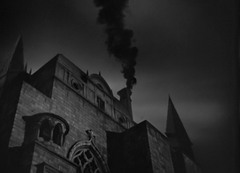
The overwhelming emotion conveyed by KANE in its final moments is an almost cosmic sense of waste: an empire and a life that has turned into junk, and is going up in smoke. If we compare this smoke to the smoke that rises at the end Of THE TRIAL, we may get some measure of the experience, intelligence, and feeling that Mankiewicz brought to CITIZEN KANE. Yet thankful as one may be to Kael for finally giving him his due, one wishes that some of the despair and terror of KANE’s ending had found its way into her tribute. Perhaps if, as Kael claims, KANE “isn’t a work of special depth or a work of subtle beauty,” the ending may be just another joke in what she calls “almost a Gothic comedy” — the final blackout gag. But for some reason, I didn’t feel like laughing.
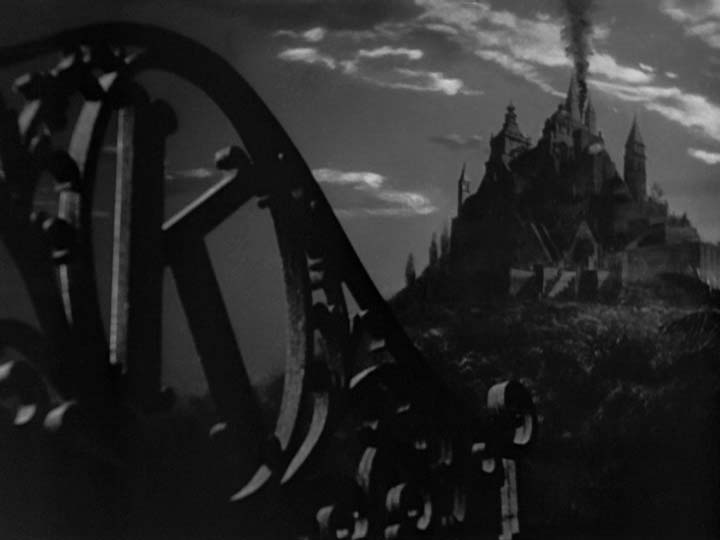
Footnotes
1. As evidence, I can cite the examples on pages 104, 234-235, and 276 as Exhibits A, B, and C. Most of the others are nearly as bad. It is also regrettable that the stills illustrate the script rather than the cutting continuity, a strategy that gives the former no chance to exist on its own (although it may subliminally–and unfairly–reinforce the notion that the film is more Mankiewicz’s than Welles’). A bizarre consequence is that some of the images shown, like the famous cockatoo, misrepresent the script. And for the record, the shot shown on pages 116-117 is out of sequence, misplaced by some 93 pages.
2. An anthology edited by McBride, and published by the Wisconsin Film Society Press in 1968. In the same collection is an article on THE MAGNIFICENT AMBERSONS, also by McBride, which is probably the most useful account of the film that has yet been written — including a rather complete description of the original 135-minute version that far surpasses the inadequate summary given in Charles Higham’s The Films of Orson Welles.

